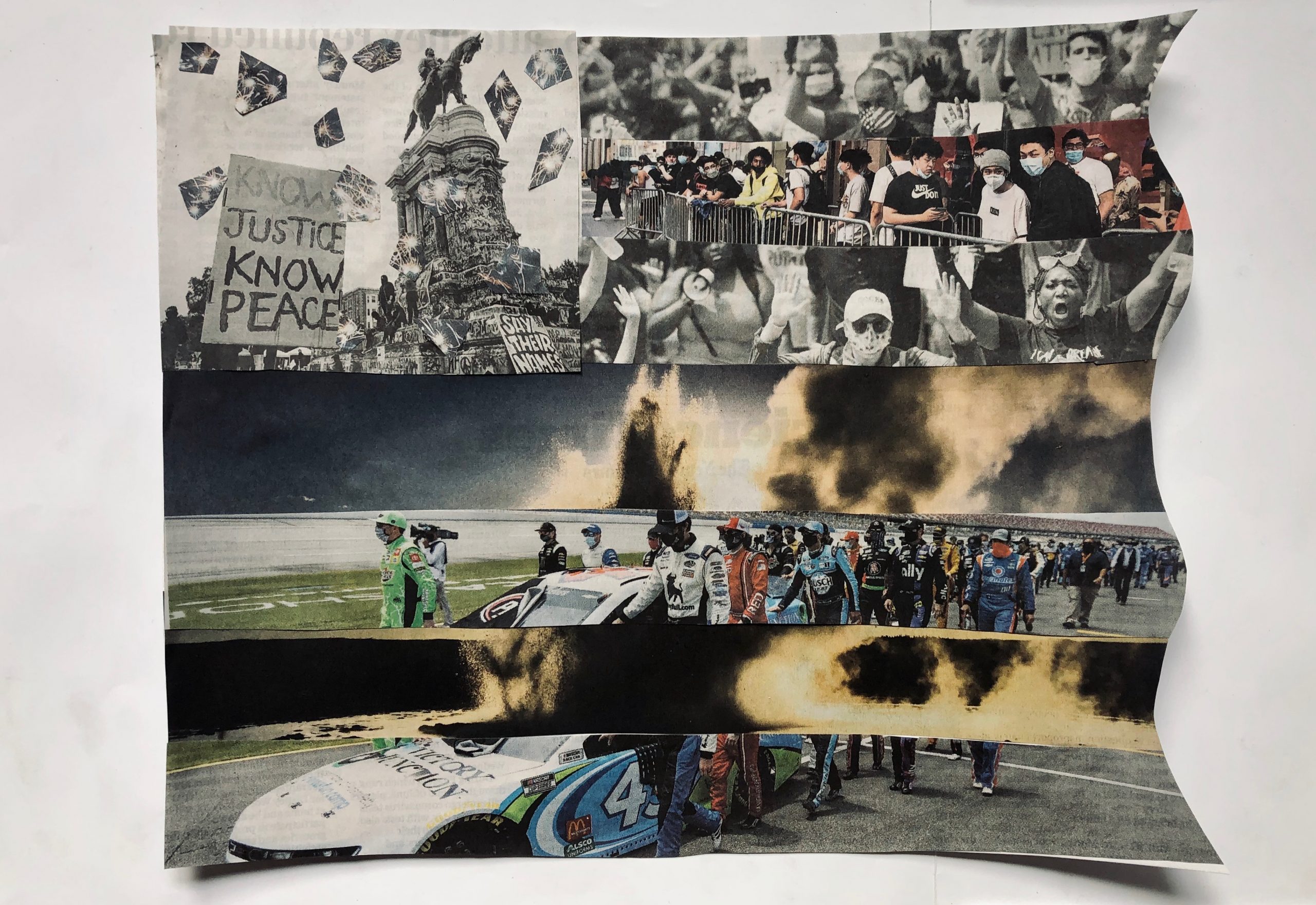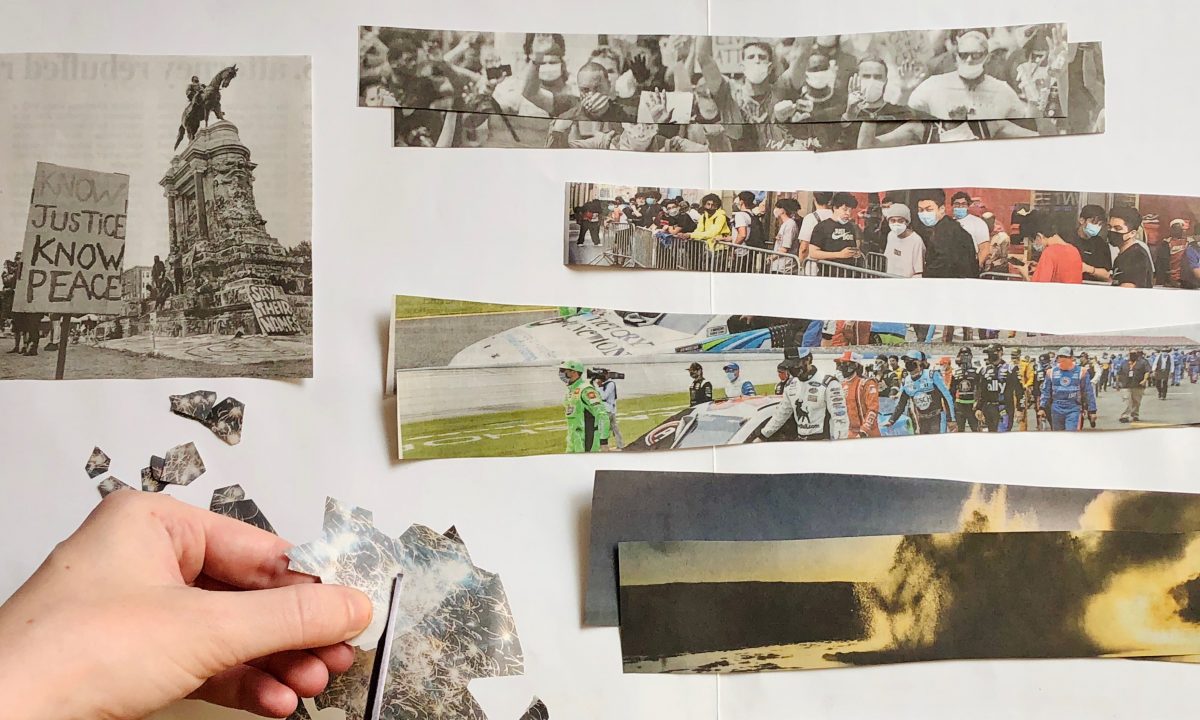Collage Flag

What is America to you? Collage your own flag inspired by Nam June Paik’s Video Flag, representing your own experiences and ideas.
We want to see your creations! Share on social media @hirshhorn with #HirshhornInsideOut.
Time: 45–60 minutes
Skill Level: Advanced
Topic: Collage
Look closely

Nam June Paik, Video Flag, 1985-1996. Hirshhorn Museum and Sculpture Garden, Smithsonian Institution, Washington, DC, Holenia Purchase Fund, in memory of Joseph H. Hirshhorn, 1996. The ongoing preservation of Video Flag is supported by the Hakuta Family Conservation Fund.
What do you see? Describe the colors and patterns. Do you recognize any shapes?
What does this artwork remind you of? What makes you say that?
This artwork is called Video Flag. It is constructed of seventy television monitors that were made in the 1980s and ’90s. Video Flag is almost 8 feet tall and 12 feet long. Each monitor on its own displays a rotating set of videos. When viewed as a whole, the visuals come together to create the feeling of the American flag design. Each monitor is connected to a timer so the images change quickly and show the viewer different flag visuals.
American artist Nam June Paik was born in Korea but fled in 1950 at the start of the Korean War. He moved to Hong Kong, Japan, and Germany, before finally settling in New York City. He is considered the founder of the video art movement. He began using television as a medium in the 1960s, and continued creating work in that medium for several decades. In 1996, the Hirshhorn commissioned Paik to create Video Flag. Paik thinks of Video Flag as a collage, carefully selecting images to display together. The images the artist chose include stars and stripes, a sequence of American presidents beginning with Harry Truman and ending with Bill Clinton, and broadcast news. While a flat paper collage displays the same images together constantly, this work is dynamic. The use of 70 TV monitors allows for multiple images to display at a time. The images flash by quickly, and when some images are viewed together, rather than alone, it changes the way we think about and understand them. The images flash by quickly, making the viewer have to stop and look, revealing moments we might not have otherwise noticed. Paik uses the television as another symbol of America to make us look closely at how we think about—and how the media depict—being American.
Make IT
For this project, we take inspiration from Paik’s Video Flag and create our own paper collage flag using news clippings. We will use newspaper clippings, a form of paper media, instead of video media.
- Gather your materials: You’ll need a newspaper or magazine, a piece of paper (to serve as the canvas), scissors, and glue.

- Talk together about the American flag. Where have you seen it before? What do you know about it? The American flag is a symbol of the United States and its people.
Did you know? The first American flag design was created in 1777, shortly after the United States gained independence from Britain. The design we see today, that features 50 stars, was created in the late 1950s by a high school student who sent his design to Congress. As you design your collage flag, think about how you want to represent America. - What do you think of America, what images and ideas come to mind? Talk together. America means many things to different people. A note to adults: This is a good conversation to have together. Let your child share first, then tell them about your own experiences with America, good or bad. The age of your child will impact the complexity of their ideas. Younger children are likely to reference common symbols and colors: stars; red, white, and blue—and that is fine! Children ages 8+ will be able to have more complex conversations, and make connections between the symbols, history, and current events. Let older children grapple with complexity, and use the collaging of conflicting images to talk about how those many meanings can exist side by side.
- Choose your images. Look through your newspaper or magazines for images that interest you or show the idea of America you just talked about. You might also include your own drawings. For our project, we chose images of fireworks, protests, a geyser at Yellowstone National Park, a statue, Nascar drivers, and people waiting in line for a shoe store.

- Cut out your images. Use scissors to cut out the images you chose. You may want to keep the images the size they are or cut the images into smaller pieces. We did both in our project.
Note: Smaller hands may need help holding the newspaper or cutting out the images.

- Plan your composition. Lay out your canvas and explore different ways of placing your images. You may choose to follow the composition of the American flag, with a rectangle in the upper left corner and horizontal stripes covering the remaining space, or you may choose your own special composition. Choose the composition that best shares your ideas.

- Glue your images to your canvas. Apply glue to the back of the image and place it on your canvas. Remember the composition you want to make! We followed the traditional American flag composition, but cut the edges of our paper to make it look like the flag is waving in the wind.

- Title your work! We named ours 2020 America.